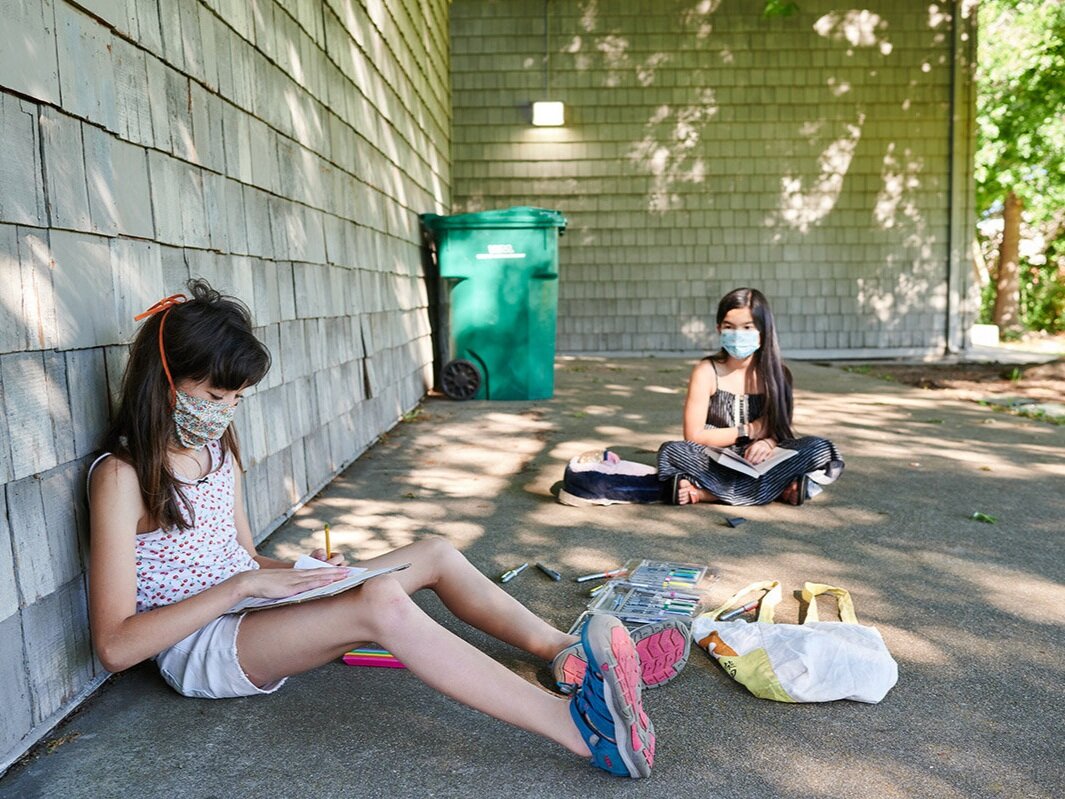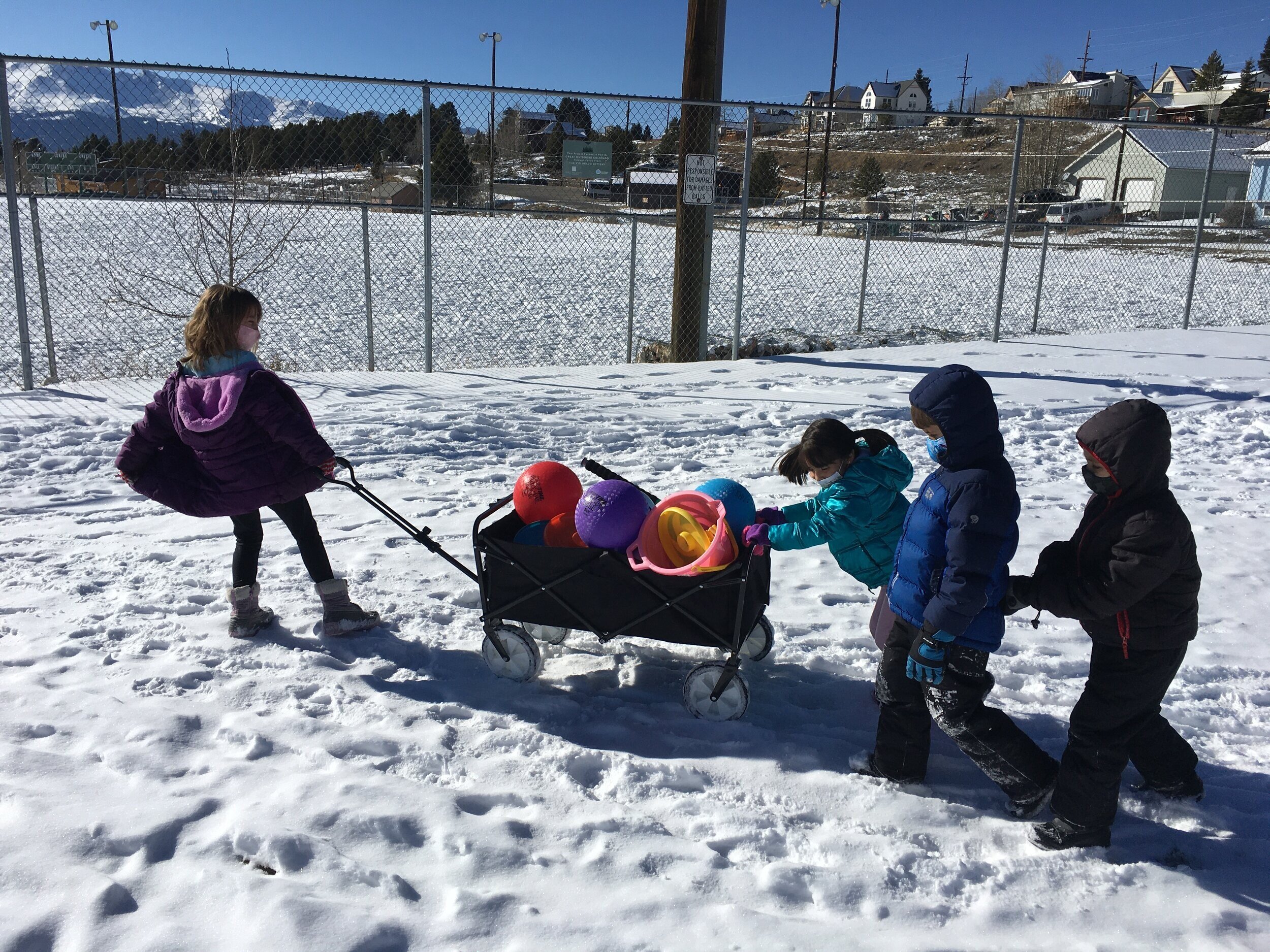Using Public Spaces as Outdoor Classrooms
Most schools and school districts begin their planning process for outdoor learning by considering the spaces available on their own grounds, right outside their buildings. School grounds are a logical first choice for many schools, since they are conveniently located close to teaching supplies, Wi-Fi, meal service, and other resources stored inside school buildings.
As schools and districts consider how best to take learning outside during the pandemic, many will find that their own campus cannot accommodate all of the students or programs they wish to have outdoors. In those cases, it is important to think beyond the campus boundaries, to imagine new possibilities in the wider community.
Parks, public lands, closed streets, and other outdoor spaces offer valuable opportunities to extend learning beyond the school site, into the neighborhood. This is a particularly useful approach for schools with limited footprints, dense multi-storied classroom buildings, few existing outdoor facilities, or sites at which space is shared by multiple school partners with competing demands. Schools with the least amount of resources and smallest campuses are poised to benefit the most from moving offsite into parks and other public spaces.
It is important to recognize that not everyone has the same access to well-maintained parks and public spaces that support learning. Many cities have an uneven distribution of parks, limited public transportation, and wide variation in the accessibility, size, and quality of available spaces. In addition, not everyone feels welcome and included in public spaces. Historically, white supremacy culture and ableism determined who had access to, is welcome, safe, and has a voice in these spaces, even in instances where BIPOC, people with differing abilities, and LGBTQ+ communities have long traditions of connections to the land. Outdoor learning presents an opportunity to reinvigorate local communities’ connections to outdoor spaces.
Each school and community is unique and may be starting from a different place. There is no one-size-fits-all model for outdoor learning and many different solutions are possible. Creative thinking outside the campus opens doors (literally!) for many schools and districts that would otherwise be unable to access the fresh air as well as the benefits for learning and mental, physical, and emotional health that nature affords.
Planning Materials for Outdoor Learning Offsite
Moving school classes and programs offsite and into outdoor spaces in the community is useful and rewarding, but also takes some specialized planning to efficiently accomplish. We recommend that plans to move learning offsite be undertaken at the school district level, rather than by individual schools, so that a whole school district may partner with their local parks department or another city agency to seek integrated, systemic solutions that will create consistent, equitable outcomes for all students. The articles below are intended to address some of the key planning and logistical questions related to using offsite locations for outdoor learning this year.
Planning Processes and strategies
Planning Strategies for Using Parks
and Open Spaces for Outdoor Learning
This article is the first part of the introduction to the planning process school districts can use to help them move outdoor learning offsite into parks and other public spaces.
Identifying Outdoor Learning
Opportunities Offsite
This article is the second part of the introduction and explores planning considerations and search tools for districts interested in moving learning offsite.
Assessing Suitability of Potential Outdoor Learning Spaces Offsite
This article is intended to help school districts fine-tune their site selection process and assess potential offsite outdoor learning spaces in the community.
Property Manager Guidance
This article is written for owners and managers of parks and other public spaces to help guide their planning process as they consider partnering with school districts to support outdoor learning on their grounds.
(Coming soon!)
Emergency Preparedness for Teaching in Parks and Other Offsite Locations
Holding daily classes on parkland or other outdoor spaces in the community requires some preparation to adjust standard emergency planning and preparations for new environments.
What to Bring Offsite? Planning Supplies for Teachers and Students
Teaching in parks or other outdoor spaces in the community is usually easier to do when teachers and students bring supplies with them that facilitate outdoor learning.
(Coming soon!)
Planning School Transportation
Most school districts have struggled to establish protocols to reduce the risk of virus transmission for students who ride buses and use public transit. This article provides some health-related guidance and framing.
Creating a Written Agreement Between a Property Owner and a School District
This article provides an overview of what is needed to establish a Memorandum of Understanding between a property owner (such as a park agency) and a school district.
Memorandum of Understanding (MOU) Template for District-Park Partnerships
Download a template that school districts and park agencies can use to begin crafting an agreement to allow outdoor learning onsite. Click for MS Word or Google Doc format.
City- and State-Scale Planning Examples
The first two examples below are case studies of school districts that are using local parks and other offsite locations to accommodate a portion of their outdoor learning needs. The three mapping examples that follow include two city-scale maps intended to illustrate the potential for school-park partnerships, and a state-scale map that evaluates the equity of park distribution on a wider scale.
Case Studies
Texas — Austin Independent School District
Case Study
Austin Independent School District is using local parks as outdoor learning venues for many of its schools.
Colorado — Lake County School District
Case Study
Lake County School District’s motto is “Learning Beyond Walls.” Their students regularly engage in nature-based learning onsite and in nearby public lands.
Mapping Tools to Evaluate School and Park Proximity
California — San Francisco Map of Schools and Open Spaces Citywide
This article and its accompanying map show the locations of all of the schools in San Francisco and many types of parks and public spaces that can be used for outdoor learning.
Maryland — Maryland Park Equity Mapper, Maryland Department of Natural Resources
This interactive, quantitative tool is intended to help evaluate the existing distribution of park space, so future park planning can expand public access for underserved communities.
Texas — Austin Independent School District Map of Off-Campus Green Spaces for Outdoor Learning
Austin ISD created an interactive online map of school properties and local parkland to facilitate off-campus outdoor learning.
Credits
The resources and strategies in this chapter were developed by the National COVID-19 Outdoor Learning Initiative’s Working Group on Parks and Offsite Learning Spaces (WG#3). This working group was led by Trudy Garber from The Trust for Public Land and Jenny Mulholland-Beahrs from Inclusion Outdoors, and included more than two dozen dedicated volunteers from around the country. We would like to express our heartfelt thanks to all of the organizations and individuals who are collaborating to make this Initiative possible.
National COVID-19 Outdoor Learning Initiative
The National COVID-19 Outdoor Learning Initiative supports schools and districts around the country in their efforts to reopen safely and equitably using outdoor spaces as strategic, cost-effective tools to increase physical distancing capacity onsite and provide access to abundant fresh air. The Initiative seeks to equitably improve learning, mental and physical health, and happiness for children and adults using an affordable, time-tested outdoor approach to keeping schools open during a pandemic.
The National COVID-19 Outdoor Learning Initiative was co-founded in May 2020 by Green Schoolyards America, The Lawrence Hall of Science, San Mateo County Office of Education, and Ten Strands. It has now grown to include more than 20 other partner organizations that are collaborating to build a national movement, hundreds of participating volunteers, and foundation partners.






















